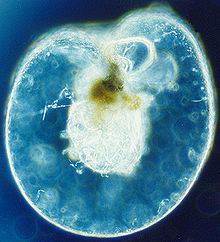Domain Eukaryota Phylum Dinoflagellata Rank Order | Scientific name Noctilucales Higher classification Noctiluciphyceae | |
 | ||
Similar Noctiluca scintillans, Ceratium, Noctiluca, Gonyaulax, Gymnodinium | ||
The Noctilucales are an order of marine dinoflagellates. They differ from most others in that the mature cell is diploid and its nucleus does not show a dinokaryotic organization. They show gametic meiosis.
Contents
Characteristics
These cells are very large, from 1 to 2 millimetres in diameter, and are filled with large buoyant vacuoles. Some may contain symbiotic green algae, but there are no chloroplasts. Instead, they feed on other plankton, and there is usually a special tentacle involved in ingestion.
Noctilucales reproduce mainly by fission, but sexual reproduction also occurs. Each cell produces numerous gametes, which resemble more typical athecate dinoflagellates and have the dinokaryotic nuclei. Evidence suggests that they diverged from most other dinoflagellates early on, and they are generally placed in their own class.
Taxonomy
Examples
The most common species is Noctiluca scintillans, also called N. miliaris. It can be bioluminescent when disturbed, as are various other dinoflagellates, and large blooms can sometimes be seen as flickering lights on the ocean, known as the milky seas effect.
Another example is Spatulodinium pseudonoctiluca.
